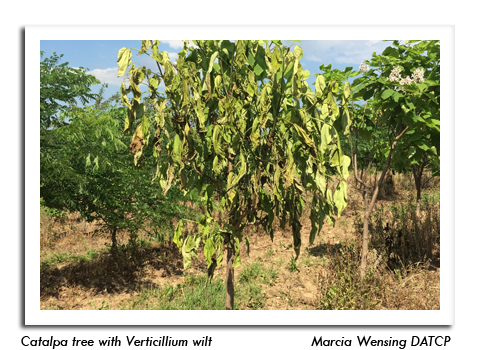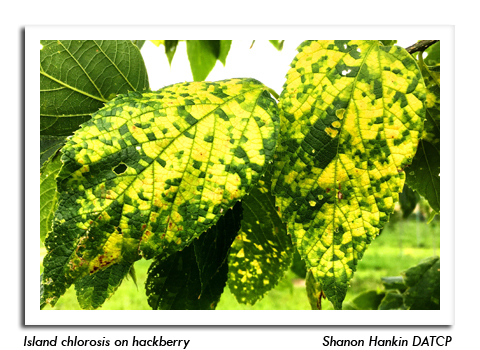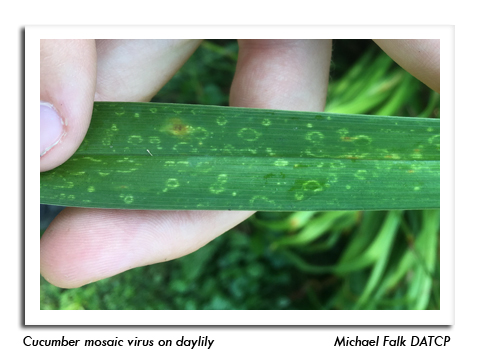
 |
|
|
Nursery & Forest
Volume 62 Number 16 Date 08/17/2017 VERTICILLIUM WILT - Catalpa trees in a southern Wisconsin nursery were exhibiting symptoms of this fatal vascular disease, frequently misidentified as decline caused by environmental factors. Verticillium is a soil-borne fungus that first invades trees through weakened areas of the roots. Once inside the tree, the fungus spreads upward and infects the phloem. Acute symptoms include wilting and dieback which can lead to mortality. Trees with severe wilt and dieback cannot be saved. Because the causal fungus can persist in the roots and soil, diseased trees should be replaced with a species not susceptible to Verticillium such as aspen, beech, sycamore, poplar, willow or any conifer. HACKBERRY ISLAND CHLOROSIS - This virus of hackberry trees has been found by inspectors at several nurseries. Symptoms include sharp blocky, bright yellow spots on the leaves that follow the veins, with a distinct margin between the green and yellow areas. Severely affected foliage turns mostly yellow by late summer. Hackberry island chlorosis is thought to be spread by seed and aphid probing. As with all viral diseases, there are no practical curative treatments. Maintaining tree vigor is the best preventative measure. DOWNY MILDEW - This fungal disease has been a common problem in nurseries this season, on grapes, cranberry-bush viburnum, and many other plants. Downy mildew thrives during periods of cool weather and high humidity, and is recognizable by whitish mold that develops on the leaf undersides, stems, and on fruits. Upper leaf surfaces may show yellowing opposite the moldy leaf undersides. Mildew occurrence can be minimized by reducing humidity and improving air circulation. The fungus overwinters as spores on old leaves, so thorough end-of-season sanitation is important where mildew infection has been severe. EASTERN SPRUCE GALL ADELGID - These distinctive galls were found on white spruce at a nursery in southern Wisconsin. Feeding by adelgid nymphs in spring triggers gall formation, which in aggregate appears as a pineapple-shaped growth. Eventually the galls dry, turn brown and split open, allowing the adult inside to emerge, usually from late July to October. There is generally one generation per year. Dormant oil treatments made in October and November, or in April, are usually effective against this pest. CUCUMBER MOSAIC VIRUS - Daylilies at a nursery in southern Wisconsin were recently diagnosed with this virus. Symptoms include stunting, a yellow-green mosaic pattern on the foliage, and yellow leaf streaks and/or spots. Because these general symptoms are similar to herbicide damage and other disorders, CMV must be confirmed by laboratory diagnosis. There is no cure for this virus. Preventive measures include removal of infected plants, control of aphids (likely transmitters), and purchasing clean stock. -- Shanon Hankin, DATCP Nursery Inspector WILLOW PINECONE GALL MIDGE - The conspicuous "pinecones" observed on willow trees in Price County were identified as galls of the pinecone gall midge, a tiny fly which induces the formation of new galls when the female lays a single egg in the terminal buds of willows in spring. Each gall contains a midge larva that overwinters, pupates in March or April, and emerges as an adult around May. The galls cause no appreciable harm and should be tolerated. -- Timothy Allen, DATCP Nursery Inspector 




|
|
|